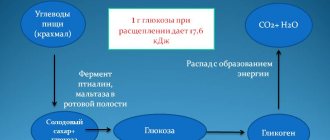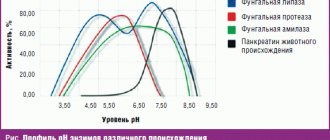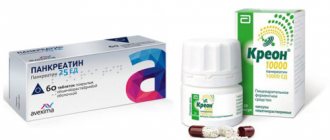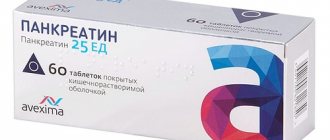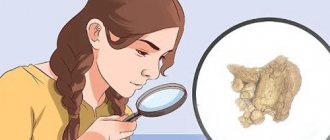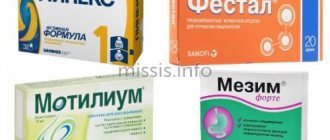- General properties of enzymes
- Classification
- Digestive enzymes
- The role of replacement therapy with the drug "Micrazim"
The life of any organism is possible thanks to the metabolic processes occurring in it. These reactions are controlled by natural catalysts, or enzymes. Another name for these substances is enzymes. The term "enzymes" comes from the Latin fermentum, which means "leaven". The concept appeared historically in the study of fermentation processes.
Rice. 1 - Fermentation using yeast - a typical example of an enzymatic reaction
Humanity has long been using the beneficial properties of these enzymes. For example, for many centuries cheese has been made from milk using rennet.
Enzymes differ from catalysts in that they act in a living organism, while catalysts act in inanimate nature. The branch of biochemistry that studies these essential substances for life is called enzymology.
Pancreatic enzymes - types and functions
It's time to learn what enzymes are and how they affect digestion. Pancreatic enzymes are protein complexes or catalysts whose main task is to break down nutrients into simple, easily digestible compounds. Thus, the body easily absorbs all the necessary elements and vitamins.
With a lack of pancreatic enzymes, food is not digested fully, not all beneficial substances are absorbed, which affects the condition of the entire body1.
What enzymes does the pancreas produce and what are their functions?
The pancreas produces several types of enzymes, each of which does its own thing1,2.
- Proteases – break down proteins into amino acids;
- Lipases – decompose fats into fatty acids;
- Amylases - break down sugar (carbohydrates) and starch.
The amount of enzymes released is measured in units. The pancreas can produce up to 2 million units of enzymes per day. In this case, it is customary to take lipase units as a unit of measurement, since fats are the most difficult food components to digest8.
Now let’s look at the principle of how enzymes work, and to do this we’ll have to remember about the digestion process as a whole. The main task of digestion is to absorb all the nutrients that come with food. To do this, food must be disassembled into “bricks”. The process begins literally in the mouth, already during chewing, under the influence of saliva. Next, the food enters the stomach - the kingdom of gastric juice and the enzyme pepsin, where it acquires a mushy form and then, already prepared nutrients, enter the intestines in small portions.
It is in the intestines that the main stage of digestion occurs. Let us examine this stage in more detail, since it is directly related to pancreatic enzymes8.
After food enters the duodenum (the first section of the intestine after the stomach), it begins to be affected by the secretion (juice) of the pancreas, which contains digestive enzymes. At rest, the pancreas does not produce enzymes, but is in “standby mode.” But it is enough to catch the alluring smell of food or see a tasty dish, as the brain instantly gives the command to start working, and the pancreas begins to actively produce enzymes. This continues during meals and for some time after, because food does not reach the intestines instantly8.
It is especially interesting that the body can regulate the production of certain enzymes depending on the nature of the food consumed. That is, if you consume a lot of baked goods, then the emphasis in production will be on amylase, if you consume fatty foods, then the pancreas will send more lipase to the intestines.
It seems that the work is completely smooth and there can be no failures. But failures happen quite often: the operating mechanism is too delicate and easy to break. Even a large meal with a predominance of fats can break down the system, and the pancreas will not be able to provide the required amount of enzymes.
Chronic pancreatitis and other conditions
Chronic pancreatitis and other conditions
Pancreatic enzyme medications are among the most commonly used medications. This is due to two factors: the high prevalence of indigestion and their negative impact on the quality of life and the safety of these drugs (close to physiological).
The most important and most motivated indication for prescribing pancreatin drugs is the absence of exocrine (digestive) pancreatic enzymes, when replacement therapy with these enzymes is required.
Complete (true) pancreatin deficiency most often occurs in patients with chronic pancreatitis. It is worth remembering that overdiagnosis of chronic pancreatitis is a common occurrence in clinical practice.
It has been found that the exocrine reserve of the pancreas is very high, so pancreatin (digestive enzyme) deficiency becomes clinical (symptomatic) only when the pancreatic tissue is severely damaged.
Special studies show that symptoms of exocrine pancreatic insufficiency occur in about 90% of patients. The parenchyma of the pancreas, and its remaining functionally active tissue, is not able to satisfy the need for enzymes necessary for digestion.
Chronic pancreatitis is not a common disease. Most often (up to 75-80% of cases), it occurs in people with chronic alcoholism. Research shows that signs of chronic pancreatitis (including enzyme deficiency) occur within an average of 10 years of continuous alcohol consumption. What in everyday life (sometimes in everyday clinical practice is called “chronic pancreatitis”) often turns out to be a digestive disorder of another etiology, including psychogenic, functional.
The appearance of digestive problems
We have found that digestive problems can occur due to a lack of enzymes. There are two main mechanisms by which the body lacks pancreatic enzymes. In the first option, the problem with the production of enzymes lies in the pancreas itself, i.e. the organ itself is not functioning properly.
Impairment of the pancreas can be a congenital problem or acquired, for example, after surgical interventions. As a rule, such a mechanism underlies serious diseases of the gastrointestinal tract (GIT), the symptoms of which will sooner or later lead to an appointment with a doctor8.
In the second option, the conditions under which enzymes can work correctly are violated. This is possible as a result of changes in the acidity of the intestinal environment, for example, due to inflammation or a change in the standard ambient temperature (36-37 ° C). The inflammatory process in the intestines can occur under various conditions: intestinal infections, allergic reactions (food allergies, atopic dermatitis).
Principles of treatment
Depending on the cause and course of exocrine pancreatic insufficiency (absolute, long-term or relatively short-term), treatment can be episodic or long-term.
In case of irreversible pancreatic insufficiency, enzyme preparations must be used for a long time, even throughout life, but their dose varies depending on the amount and nature of food eaten, the functional state of the digestive organs, and concomitant diseases.
Treatment consists of two stages: diet and pancreatin replacement therapy.
Main signs of pancreatic enzyme deficiency
Identifying enzyme deficiencies is quite simple. The key symptoms are heaviness after eating, a feeling of fullness in the abdomen and abdominal discomfort. Often these symptoms are accompanied by bloating, rumbling, flatulence, and diarrhea. Most often, such symptoms can occur in ordinary situations: when eating heavy, fatty foods or when overeating, when it was simply impossible to resist eating a lot of tasty dishes. In this case, you should not be afraid of problems with the pancreas or other gastrointestinal diseases. The pancreas simply cannot cope with much work and may need help.
Why does diarrhea occur? Fats are the most difficult components of food to digest. If there is a lack of enzymes in the body, it is with the processing of fats that difficulties arise. As a result, undigested fats that are not decomposed by enzymes contribute to a change in the nature of the stool and the rapid movement of contents along the intestines, which provokes diarrhea8.
If a lack of enzymes and digestive problems persist for a long time, then this does not go unnoticed by the body. Symptoms may worsen and become regular rather than episodic. Constant diarrhea gives rise to vitamin deficiency; protein-energy deficiency and dehydration throughout the body can develop. Significant weight loss may occur. In addition, in severe stages, the following symptoms of pancreatic enzyme deficiency may be observed8:
- nausea and vomiting;
- heartburn;
- a sharp decrease in appetite;
- general weakness.
Indications, classification
Pancreatic enzymes
Enzymatic preparations are widely used for diseases of the gastrointestinal tract, violations of the principles of healthy nutrition, to compensate for the lack of own production of active substances.
The classification is based on:
- The composition of the drug is enzymes only or with additional substances.
- Resistance to gastric juice.
- Particle size – tablets or capsules with microgranules.
The choice of medication and dosage depend on weight, symptoms and are selected strictly individually for each patient.
Maintaining digestion and treating enzyme deficiencies
If you have problems with digestion, enzyme preparations (more often called drugs to improve digestion) can help, the main task of which is to compensate for the lack of the body’s own enzymes. It’s not for nothing that this therapy is called “enzyme replacement”. It is critical that the enzyme preparation “mimics” the physiological process as closely as possible.
Today, there are various drugs to improve digestion. How to navigate the variety of means and make the right choice?
An effective enzyme preparation must meet the following criteria5,6:
- have an optimal particle size
- do not break down in the stomach
- quickly activate in the intestines
The drug Creon® meets all these requirements.
To learn more
1) Today, pancreatin minimicrospheres, which are contained only in the drug Creon®5,7, are recognized as the optimal particles. The invention of minimicrospheres was the result of many years of work to improve the effectiveness of enzyme preparations, which left far behind drugs in the form of tablets and capsules with other types of particles inside: pellets, mini-tablets, etc. In addition, Creon® minimicrospheres are produced using patented technology, which prevents other manufacturers from reproducing the same release form.
2) Creon® minimicrospheres are enclosed in a capsule that protects them from the destructive effects of the stomach. But that is not all. Each particle is covered with an acid-resistant coating in order to “reach” the intestines, where its work is necessary, completely intact. At the same time, some other encapsulated drugs can lose up to 30% of their activity6.
3) Creon® begins to work within 15 minutes after entering the intestines, improving digestion and thereby eliminating heaviness and discomfort after eating6.
Creon® has several dosages, including 10,000 IU of lipase - the minimum required dose of lipase to improve digestion in case of dietary errors, eating heavy foods and overeating. To obtain the effect, Creon®10000, like any enzyme preparation, must be taken with every meal - during breakfast, lunch and dinner.
Pancreatic enzymes, a little anatomy
Pancreas: schematic anatomy
Pancreatic enzymes are a collective concept. It includes lipase, alpha-amylase, trypsin, chemotrypsin, and other biological compounds.
All of them perform various functions aimed at breaking down fats, proteins and carbohydrates into their simplest components.
The total volume of enzymes that the body produces during the day is 1 liter. The release of these biologically active substances begins after a bolus of food enters the mouth and stomach. But activation occurs only in the intestines.
- Lipase, phospholipase - promote the digestion and dissolution of fats.
- Alpha amylase - breaks down glycogen, starch and other carbohydrates into maltose.
- Trypsin, elastase, kallikrein - process protein compounds. In addition, trypsin has analgesic and anti-inflammatory effects. Included in a large number of medications.
- Chemotrypsin also promotes the breakdown of proteins.
The video will tell you about the role of enzymes:
Preparations that include pancreatic enzymes are used to correct digestive disorders, as well as to regulate the functions of the pancreas. Traditionally, complex preparations containing the main pancreatic enzymes of domestic animals (primarily lipase, trypsin, chymotrypsin and amylase) are used for this purpose. These enzymes provide a sufficient range of digestive activity (Table 1) and help relieve the clinical signs of exocrine pancreatic insufficiency, which include decreased appetite, nausea, rumbling in the abdomen, flatulence, steato-, creato- and amilorrhea.
Table 1.
Mechanisms of action of pancreatic enzymes
| Enzymes | Hydrolytic cleavage site |
| Lipolytic: lipase | Ester bonds at positions 1 and 3 of triglycerides |
| Proteolytic: trypsin chymotrypsin elastase | Internal peptide bonds between residues of: basic amino acids aromatic amino acids hydrophobic amino acids in elastin |
| Amylolytic: alpha-amylase | alpha-1,4-glycosidic bonds in glucose polymers |
The drugs differ in the activity of the components, which should be taken into account when selecting them for a particular patient (Table 2). The amylase included in the complex decomposes starch and pectins into simple sugars - sucrose and maltose. Amylase breaks down mainly extracellular polysaccharides (starch, glycogen) and practically does not participate in the hydrolysis of plant fiber.
Proteases in enzyme preparations are represented mainly by chymotrypsin and trypsin. The latter, along with proteolytic activity, is capable of inactivating cholecystokinin-releasing factor, as a result of which the content of cholecystokinin in the blood and pancreatic secretion decrease according to the feedback principle.
In addition, trypsin is an important factor regulating intestinal motility. This occurs as a result of interaction with RAP-2 receptors of enterocytes. Lipase is involved in the hydrolysis of neutral fat in the small intestine.
Combination drugs
along with pancreatin, they contain bile acids, hemicellulase, simethicone, herbal choleretic (turmeric), etc.
table 2
the online version of the article does not list
BASIC ENZYME PREPARATIONS
| Acidin-pepsin | Panzistal |
| Wobenzym | Pancreatin |
| Digestal | Pankreoflat |
| Ipental | Pankurman |
| Creon 8000 | Pancitrate 10,000 |
| Creon 25000 | Pancitrate 25,000 |
| Lycreaza | Pepphys |
| Mezim-forte | Solizim |
| Mezim-forte 10,000 | Thylactase |
| Merkenzim | Ferestal |
| Nigedase | Festal |
| Oraza | Festal N |
| Panzinorm-forte | Enzistal |
The introduction of bile acids into the drug significantly changes its effect on the function of the digestive glands and the motility of the gastrointestinal tract. Preparations containing bile acids increase pancreatic secretion and choleresis, stimulate intestinal and gallbladder motility. Bile acids increase the osmotic pressure of intestinal contents. Under conditions of microbial contamination of the intestine, their deconjugation occurs, which in some cases contributes to the activation of cAMP of enterocytes with the subsequent development of osmotic and secretory diarrhea.
Combined preparations containing bile components and hemicellulase create optimal conditions for the rapid and complete breakdown of proteins, fats and carbohydrates in the duodenum and jejunum. Drugs are prescribed for insufficient exocrine function of the pancreas, in combination with pathology of the liver, biliary system, impaired chewing function, sedentary lifestyle, short-term errors in eating.
The presence in the combined preparations, in addition to pancreatic enzymes, bile components, pepsin and amino acid hydrochlorides (panzinorm), ensures the normalization of digestive processes in patients with hypoacid or anacid gastritis. In these patients, as a rule, the functions of the pancreas, bile formation and bile excretion are affected.
Hemicellulase,
included in some drugs (festal), promotes the breakdown of plant fiber in the lumen of the small intestine, normalizing the intestinal microflora.
Many enzyme preparations contain simethicone or dimethicone, which reduce the surface tension of gas bubbles, causing them to break up and be absorbed by the walls of the stomach or intestines.
Enzyme preparations of plant origin
contain papain or fungal amylase, protease, lipase (pepphysis, orase). Papain and proteases hydrolyze proteins, fungal amylase - carbohydrates, lipase, respectively - fats.
In addition to the three above groups, there are small groups of combined enzyme preparations of plant origin in combination with pancreatin, vitamins (Wobenzym) and disaccharidases (tilactase).
Release form of the drug
is an important factor determining the effectiveness of treatment. Most enzyme preparations are available in the form of dragees or tablets in enteric coatings, which protects the enzymes from release in the stomach and destruction by hydrochloric acid of gastric juice. Most tablets or dragees are 5 mm or larger in size. However, it is known that solid particles with a diameter of no more than 2 mm can be evacuated from the stomach simultaneously with food. Larger particles, in particular enzyme preparations in tablets or dragees, are evacuated during the interdigestive period, when food chyme is absent in the duodenum. As a result, the drugs do not mix with food and do not actively participate in the digestive process.
To ensure rapid and homogeneous mixing of enzymes with food chyme, new generation enzyme preparations were created in the form of microtablets (pancitrate) and microspheres (Creon, lycrease), the diameter of which does not exceed 2 mm.
The drugs are coated with enteric (enteric) coatings and enclosed in gelatin capsules. Once in the stomach, gelatin capsules quickly dissolve, microtablets are mixed with food and gradually enter the duodenum. When the pH of the duodenal contents is above 5.5, the membranes dissolve and enzymes begin to act on a large surface. In this case, the physiological processes of digestion are practically reproduced, when pancreatic juice is secreted in portions in response to the periodic intake of food from the stomach. Brief pharmacological characteristics of
Acidin-pepsin
- a drug containing a proteolytic enzyme. Obtained from the gastric mucosa of pigs. Tablets of 0.5 and 0.25 g contain 1 part pepsin, 4 parts acidine (betaine hydrochloride). Prescribed for hypo- and anacid gastritis, 0.5 g 3-4 times a day with meals. The tablets are pre-dissolved in? glasses of water.
Wobenzym
- a combined preparation containing highly active enzymes of plant and animal origin. In addition to pancreatin, it contains papain (from the Carica Papaya plant), bromelain (from common pineapple) and rutoside (vitamin P group). It occupies a special place among enzyme preparations, because along with pronounced enzymatic properties, it has anti-inflammatory, anti-edematous, fibrinolytic and secondary analgesic effects. The range of applications is very wide. Used for pancreatitis, ulcerative colitis, Crohn's disease, injuries, autoimmune oncological, urological, gynecological diseases. The dose is set individually and ranges from 5 to 10 tablets 3 times a day.
Digestal
— contains pancreatin, bovine bile extract and hemicellulase. The drug is prescribed 1-2 tablets 3 times a day during or after meals. Creon is a drug whose gelatin capsule contains a large amount of pancreatin in hydrochloric acid-resistant granules. The drug is characterized by rapid (within 4-5 minutes) dissolution of gelatin capsules in the stomach, release and uniform distribution of granules resistant to gastric juice throughout the chyme. The granules freely pass through the pyloric sphincter simultaneously with the chyme into the duodenum, completely protect pancreatin enzymes during passage through the acidic environment of the stomach, and are characterized by the rapid release of enzymes when the drug enters the duodenum.
Lycreaza
- an enzyme preparation based on an extract obtained by grinding, defatting and drying fresh or frozen pig pancreas. The capsules contain microspheres with a diameter of 1-1.2 mm containing pancreatin, are stable and do not collapse in the gastric environment with a pH below 5.5. For dyspeptic disorders, 1-3 caps/day is prescribed, for chronic pancreatitis 3-6 caps/day.
Mezim-forte
— often prescribed for the correction of short-term and minor pancreatic dysfunctions. Mezim-Forte dragee is covered with a special glaze shell that protects the components of the drug from the aggressive effects of the acidic environment of the stomach. Apply 1-3 tablets 3 times a day before meals.
Merkenzim
- a combination drug that contains 400 mg of pancreatin, 75 units. bromelain and 30 mg ox bile. Bromelains are a concentrated mixture of proteolytic enzymes extracted from fresh pineapple fruit and its branches. The drug is two-layer. The outer layer consists of bromelains, which are released in the stomach and exhibit proteolytic effects. The inner layer is resistant to the hydrochloric acid of the stomach and enters the small intestine, where pancreatin and bile are released. Bromelains remain effective over a wide pH range (3-8), and therefore the drug can be prescribed regardless of the amount of hydrochloric acid in the stomach. Mercenzym is prescribed 1-2 tablets 3 times a day after meals.
Nigedase
- a drug in tablets of 0.02 g containing a lipolytic enzyme. Obtained from the seeds of Nigella Damascus. Nigedase causes the hydrolytic breakdown of fats of plant and animal origin. The drug is active in conditions of high and normal acidity of gastric juice and is half active in conditions of low acidity of gastric juice. The drug is prescribed orally 1-2 tablets 3 times a day 10-30 minutes before meals. Due to the absence of proteolytic and amylolytic enzymes in the drug, it is advisable to combine the use of Nigedase with the use of Pancreatin.
Oraza
- an acid-resistant complex of proteolytic and amylolytic enzymes (from the culture of the fungus Aspergillus oryzae), consisting of amylase, maltase, protease, lipase. The drug is not destroyed in the stomach, dissolves in the intestines (at an alkaline pH). Prescribed 0.5 -1 teaspoon of granules 3 times a day during or immediately after meals. One teaspoon contains 2 g of granules, which corresponds to 0.2 g of oraza.
Panzinorm
- a drug consisting of an extract of the gastric mucosa, bile extract, pancreatin, amino acids. The gastric mucosa extract contains pepsin and cathepsin with high proteolytic activity, as well as peptides that promote the release of gastrin, subsequent stimulation of the gastric glands and the release of hydrochloric acid. Panzinorm is a two-layer drug. The outer layer contains pepsin, cathepsin, amino acids. This layer dissolves in the stomach. The inner layer is acid-resistant, dissolves in the intestines, and contains pancreatin and bile extract. Panzinorm has a substitutive and digestive stimulating effect. The drug is taken 1-2 tablets with meals 3-4 times a day.
Pancreatin
- a preparation of the cattle pancreas containing enzymes. The daily dose of pancreatin is 5-10 g. Pancreatin is taken 1 g 3-6 times a day before meals.
Pankurman
- a combination drug, 1 tablet of which contains pancreatin and turmeric extract (choleretic agent).
Take 1-2 tablets before meals 3 times a day. Pancitrate
is a new generation drug with a high content of pancreatin. It has pharmacodynamics similar to Creon. Gelatin capsules contain microtablets in a special enteric coating that is resistant to gastric juice, which guarantees the release of all enzymes in the intestines. Prescribed 1 capsule 3 times a day. Pepphysis - contains plant enzymes (papain, diastase) and simethicone. Unlike other enzyme preparations, pepfiz is available in the form of effervescent soluble tablets with an orange flavor, which, when dissolved in water, release sodium and potassium citrate. They neutralize hydrochloric acid in the stomach and reduce heartburn. The drug is used for hangover syndrome, overeating, heavy consumption of beer, coffee, kvass, carbonated drinks, foods rich in carbohydrates, and sudden changes in diet. Take 1 tablet 2-3 times a day after meals.
Solizim
- a lipolytic enzyme obtained from Perucillium solitum, hydrolyzes vegetable and animal fats, which leads to relief of steatorrhea, normalization of the content of total lipids and lipase activity of blood serum. The drug is taken 2 tablets (40,000 LE) 3 times a day during or immediately after meals. Thylactase is a digestive enzyme that is lactase, which is found in the brush border of the mucous membrane of the jejunum and proximal ileum. Breaks down lactose into simple sugars. Prescribe 250-500 mg orally before consuming milk or dairy products. The drug can be added to foods containing lactose.
Festal, enzistal, panzistal
- combined enzyme preparations containing the main components of the pancreas, bile and hemicellulase.
Use 1-3 tablets with meals 3 times a day. Clinical features of use
One of the important factors determining the success of treatment is the correct choice of enzyme preparation, its dose and duration of treatment. When choosing a drug, take into account the nature of the disease and the mechanisms underlying the digestive disorder. The choice of dose of the enzyme preparation is determined by the severity of the underlying disease and the degree of functional disorders of the damaged organ. Thus, the use of moderately active pancreatic enzymes is advisable in “borderline” conditions, when there are minor dysfunctions of the pancreas that accompany various diseases of the upper digestive tract or occur with errors in eating, overeating, or alcoholic excesses.
In this case, patients present subjective complaints of some malaise, occasional nausea, heaviness in the abdomen after eating. Similar symptoms occur when overeating or eating unusual, “unfamiliar” food. This is especially common among people on vacation far from their usual places of residence. A new diet, a new mineral composition of water and foods cause disturbances in the digestive processes. After 20-30 minutes. after eating, sometimes a short-term aching or pressing pain in the umbilical area may occur. In addition, there may be a short-term disorder of the stool in the form of softening (the so-called “travelers’ diarrhea”), and flatulence appears. However, with an objective clinical and laboratory examination, any pronounced changes, as a rule, are not detected.
Prescribing large doses or highly active enzymes is advisable for replacement therapy in patients with chronic pancreatitis. In this case, the dose of enzymes depends on the degree of exocrine insufficiency, as well as individual dietary habits and the patient’s desire to diet. With mild steatorrhea, not accompanied by diarrhea and weight loss, correction of digestion is achieved with a low-fat diet or taking pancitrate 10,000.
It is extremely important to consider that the dose of enzyme preparations depends on the degree of pancreatic insufficiency and on the lipase content in the preparation. When enzymes enter the small intestine, their activity drops sharply and, after the ligament of Treitz, only 22% of trypsin and 8% of lipase remain active. Consequently, even with moderate pancreatic insufficiency, lipase deficiency occurs.
With steatorrhea, more than 15 g of fat per day, as well as in the presence of diarrhea and weight loss, as a rule, the diet does not have a significant effect. Such patients are prescribed pancitrate or creon capsules containing 25,000 lipase with each meal. At the same time, you can expand the diet to include mainly vegetable fats up to 60-70 g/day. However, in some patients, symptoms of digestive disorders persist even when using high doses of enzymes. Further increase in dose, in most cases, does not improve treatment results.
The main reasons for inefficiency
enzyme therapy are:
- · inactivation of enzymes in the duodenum as a result of acidification of its contents;
· concomitant diseases of the small intestine (helminthic infestations, intestinal dysbiosis, etc.);
The activity of enzyme preparations
largely depends on factors such as intraduodenal pH and small intestinal motility, which ensure optimal duration of contact of enzymes with food chyme. When the pH in the duodenum decreases to less than 4, lipase is irreversibly inactivated, and trypsin is less than 3.5. At pH less than 5, precipitation of bile salts is observed, which is accompanied by impaired emulsification of fats, a decrease in the number of micelles of bile and fatty acids and a decrease in their absorption.
The main causes of duodenal acidification are increased secretion of hydrochloric acid and decreased secretion of bicarbonates. In these cases, together with enzyme preparations, H2-histamine receptor blockers (ranitidine, famotidine) or proton pump inhibitors (omeprazole, lansoprazole, pantoprazole, rabeprazole) are used to increase intraduodenal pH. Doses of drugs and duration of treatment are determined individually depending on the leading mechanism of this disorder. Motility disorders of the small intestine are also accompanied by impaired mixing of enzyme preparations with food chyme, which reduces their effectiveness. The use of microtablets and microspherical drugs (pancitrate, Creon, lycrease), as well as additional prescription of drugs that normalize intestinal motility (antispasmodics, prokinetics), can significantly improve treatment results.
In case of dysbiosis of the small intestine, the effectiveness of enzyme therapy can be increased by prescribing eubiotics to decontaminate the small intestine.
The choice of combined enzyme preparations is important when diseases of the biliary system and liver are combined with digestive disorders. However, it must be remembered that the use of drugs with bile acids can increase intoxication in severe chronic hepatitis and cirrhosis. In case of chronic diarrhea syndrome, in conditions of secondary malabsorption of bile acids in the intestine, their additional administration can increase diarrhea. In patients with duodenogastric reflux, the use of enzyme preparations containing bile acids (festal, digestal, panzistal, etc.) is inappropriate, since under these conditions bile acids increase the damaging effect of reflux on the gastric mucosa. It has now been established that during exacerbation of chronic pancreatitis, enzyme replacement therapy promotes reverse inhibition of gland secretion, reducing hypertension in the ducts, resulting in an analgesic effect.
It is important to consider that in case of chronic pancreatitis, enzyme preparations should not reduce the pH of the stomach, stimulate pancreatic secretion and increase diarrhea. The drugs of choice in such cases are those that do not contain bile and extracts of the gastric mucosa (pancreatin, somilase, solizym, trienzyme, creon, pancitrate, etc.). In hyperacid conditions, the inclusion in complex therapy of dosage forms containing components of gastric juice (panzinorm) is pathogenetically unjustified. The use of panzinorm for hyperacid gastritis and peptic ulcers increases the activity of proteolytic enzymes and increases the acidity of the stomach, which can clinically manifest itself as a debilitating symptom such as heartburn.
To correct creatorrhea, smaller doses of drugs are required, since the secretion of pancreatic proteases remains preserved for a long time even with pronounced structural changes in the pancreas. In addition, in enzyme preparations taken orally, the activity of lipase and then proteases decreases first. Enzyme preparations for CP with exocrine insufficiency are prescribed for a very long time, often for life. Their doses can be reduced when following a strict diet with limited fat and protein and should be increased when the diet is expanded.
The effectiveness of treatment with enzyme preparations
assessed clinically and by laboratory diagnostic methods.
In this case, the most informative are scatological examination of feces and tests based on determining the excretion of fat in feces. Research is carried out using the Van de Kamer method (quantitative determination of fats in feces), infrared spectrophotometry, radioisotope and other methods. Currently, the elastase test is widely used to assess exocrine pancreatic insufficiency. Unlike existing non-invasive tests, the elastase test can detect endocrine pancreatic insufficiency already in the early stages of the disease. Elastase in feces most reliably reflects exocrine pancreatic insufficiency, because unlike other enzymes, it is not inactivated during transit through the intestines. The standard elastase coprology test contains monoclonal antibodies to human pancratic elastase. Tolerability and side effects
Side effects when using enzyme preparations are extremely rare (less than 1%) and are most often dose-dependent. Increased levels of uric acid may be observed in the urine of patients using high doses of pancreatic enzymes. Hyperuricosuria promotes the precipitation of uric acid in the tubular apparatus of the kidney, creating conditions for the development of urolithiasis. Patients with cystic fibrosis who use high doses of pancreatic enzymes for a long time may develop interstitial fibrosis. With celiac disease, against the background of atrophy of the mucous membrane of the small intestine, the exchange of purine bases in the blood of patients changes sharply with the accumulation of high concentrations of uric acid and an increase in its excretion. Enzyme preparations are used with caution in patients with gout. In some cases, patients taking enzymes may experience diarrhea, constipation, discomfort in the stomach, nausea, and irritation of the perianal area. The main contraindications for prescribing enzyme preparations containing bile components are acute and chronic pancreatitis, acute and severe chronic liver diseases, diarrhea, inflammatory bowel diseases, a history of allergic reactions to pork or beef.
Thus, therapy with enzyme preparations should be carried out differentiatedly, taking into account the mechanism of development of the disease underlying the digestive disorder. The availability of highly active microtablets and microgranular preparations at the doctor’s disposal can significantly increase the effectiveness of enzyme treatment.
Literature:
1. Grebenev A.L., Myagkova L.P. Intestinal diseases. M., 1994.- 397 p. 2. Grigoriev P.Ya., Yakovenko A.V. Reference Guide to Gastroenterology. M., 1997.- 476 p. 3. Zlatkina A.R., Belousova E.A., Nikitina N.Yu., Sileverstova T.R. Modern enzyme therapy of chronic pancreatitis. Ross. journal of gastroenterol., hepatol., coloproctol., 1997.- No. 7 (5).- P. 109-111. 4. Ivashkin V.T., Minasyan G.A. Treatment of chronic pancreatitis. Ross. journal of gastroenterol., hepatol., coloproctol., 1996.- No. 5 (4) - pp. 10-17. 5. Kokueva O.V. Treatment of chronic pancreatitis. - Krasnodar, 2000. - 48 p. 6. Yakovenko E.P. Enzyme preparations in clinical practice // Klin. Pharmacol.1998, V.7 No. 1.- P.1-5.
